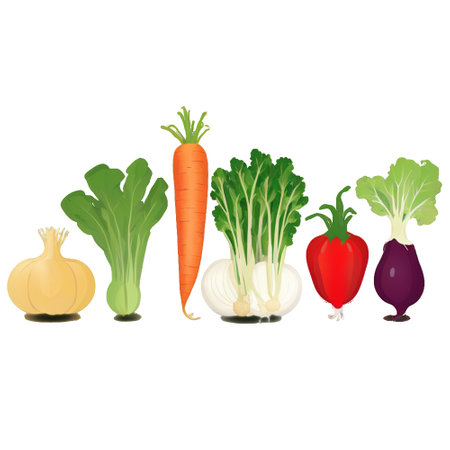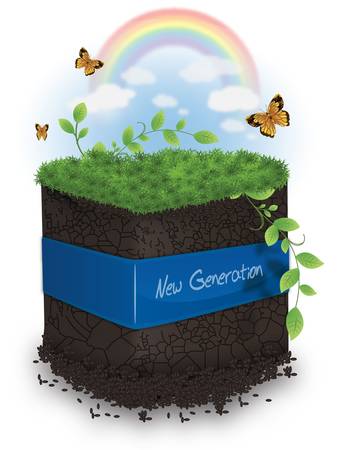Introduction: The Foundation of a Thriving Garden
In the heart of every beautiful American garden lies an often-overlooked hero—soil. Far more than just the ground beneath our feet, soil is the living foundation that determines whether your landscape flourishes or falters. From the wild prairies of the Midwest to the lush coasts of the Pacific Northwest, understanding the nuances of soil types is essential for any gardener aiming to create a vibrant and resilient outdoor space. The unique composition of your gardens soil directly influences how water is absorbed, retained, and made available to plant roots—a critical relationship that shapes irrigation strategies across the United States. In this exploration, we’ll uncover why soil type matters so much in American gardening culture and set the stage for mastering the art of watering in harmony with your land’s natural character.
2. Common Soil Types in the U.S.
Across the vast and varied landscapes of the United States, soil types shift with climate, topography, and geological history. Understanding these regional differences is essential for designing irrigation systems that nurture vibrant gardens. Let’s take a closer look at several prevalent American soil types and how their unique characteristics influence water movement and retention.
Overview of Major U.S. Soil Types
| Region | Soil Type | Description | Irrigation Considerations |
|---|---|---|---|
| Midwest | Loam | Rich mix of sand, silt, and clay; fertile and well-draining | Holds moisture without waterlogging; ideal for most plants |
| Southeast | Clay | Dense, heavy soils with fine particles; sticky when wet | Prone to compaction and slow drainage; needs careful watering to avoid root rot |
| Southwest | Sandy | Coarse, gritty texture; fast-draining but low in nutrients | Loses moisture quickly; requires frequent, light irrigation |
| Northeast & Pacific Northwest | Silty/Alluvial | Smooth, soft soils from river deposits; fertile but can compact easily | Retains moisture well; monitor for overwatering in wet climates |
The Role of Regional Climate in Soil Formation
The interplay between climate and soil cannot be overstated. In humid eastern states, rich loams and clays dominate, supporting lush lawns and diverse plantings. Western arid regions yield sandy or rocky soils that demand drought-tolerant landscaping approaches. Meanwhile, mountain zones may feature shallow, stony soils requiring thoughtful plant selection and specialized irrigation techniques.
The beauty of American garden design lies in celebrating these local soil identities—whether you’re nurturing roses in Ohio’s loamy beds or coaxing succulents from Arizona’s sunbaked sands. Recognizing your region’s foundational earth empowers you to create sustainable, thriving landscapes that honor place as much as planting palette.

3. How Soil Texture Influences Water Movement
Soil texture is the unique combination of sand, silt, and clay particles that determines how water moves through your garden soil. In the context of American garden design, understanding this relationship is essential for creating thriving landscapes and lush outdoor spaces. Sandy soils, with their large particles, allow water to drain quickly. While this prevents soggy roots, it also means water—and essential nutrients—can wash away before plants have a chance to absorb them. Conversely, clay soils are made up of fine particles that pack closely together. This tight structure helps retain moisture but can easily become waterlogged, suffocating roots and hampering plant health if not managed with proper irrigation techniques.
Silty soils fall somewhere between sand and clay in terms of particle size and water movement. They offer moderate drainage and fair nutrient retention, making them popular in many U.S. gardens. However, even silty soil can compact over time, restricting air flow to plant roots and impacting overall garden vitality.
From a landscape designer’s perspective, tailoring your irrigation approach to your soil’s texture is key. For sandy gardens, consider shorter, more frequent watering sessions to keep root zones moist without waste. In clay-rich beds, deep and infrequent watering encourages roots to grow deeper while avoiding surface saturation. Amending native soil with organic matter such as compost can improve both drainage in heavy soils and water retention in fast-draining ones, helping you craft a resilient garden that flourishes within America’s diverse climates.
4. Matching Irrigation Methods to Your Soil Type
Knowing your garden’s soil type is only the beginning—choosing the right irrigation method is essential to ensure your plants thrive, conserve water, and minimize problems like runoff or root rot. Each soil type in American gardens responds differently to water, so tailoring your watering strategy can make all the difference. Below, explore recommended irrigation techniques for each major soil category commonly found across the U.S.
| Soil Type | Irrigation Recommendation | Key Tips |
|---|---|---|
| Sandy Soil | Drip Irrigation or Soaker Hoses |
|
| Clay Soil | Sprinklers with Low Flow or Drip Systems |
|
| Silty Soil | Drip Irrigation or Fine Spray Sprinklers |
|
| Loam Soil | Most Methods (Drip, Soaker, Sprinkler) |
|
Preventing Overwatering and Runoff
Regardless of soil type, it’s vital to water early in the morning or late afternoon to reduce evaporation. Always check soil moisture before watering—overwatering is a common mistake that leads to shallow roots and disease. Consider integrating smart irrigation controllers that adapt schedules based on weather data and soil sensors for precise hydration tailored to your landscape’s unique needs.
5. Amending Soil for Better Irrigation
Transforming your garden’s soil is a journey that brings beauty and resilience to your landscape. In the diverse climates of the U.S., amending soil is essential for achieving optimal irrigation, whether you’re cultivating a lush Pacific Northwest border or a sun-baked Texas xeriscape. Improving soil structure means giving roots what they crave: balanced moisture, rich nutrients, and room to grow.
Enrich with Organic Matter
The heart of healthy soil lies in its organic content. Work compost—homemade or locally sourced—into your beds each spring and fall. This boosts water retention in sandy soils and increases drainage in heavy clays, making it a universal solution. For American gardens, leaf mold, well-rotted manure, and worm castings are excellent choices. Spread a generous two to three inches over the soil and gently mix it in with a garden fork.
Mulch for Moisture Management
Mulching is more than a finishing touch—it’s an act of stewardship. Apply a two-to-four-inch layer of mulch (such as shredded bark, pine straw, or cocoa hulls) around perennials, shrubs, and even vegetable rows. Mulch insulates roots from summer heat and winter chill, locks in precious moisture, and suppresses weeds that compete for water. In regions prone to drought, like California or Arizona, use gravel or decomposed granite for a low-water design that’s both practical and visually grounding.
Choose Region-Appropriate Amendments
Every garden tells the story of its place. In the acidic soils of the Northeast or Pacific Northwest, blend in lime to raise pH and promote nutrient uptake. For the Midwest’s dense clay, gypsum can help break up compacted earth without altering pH drastically. In the arid Southwest, add composted mulch and consider incorporating native sand to improve porosity while supporting desert-adapted plants.
Practical Tips for Gardeners
- Test your soil before amending—most county extension offices offer affordable kits tailored for local conditions.
- Avoid working wet clay; wait until it crumbles easily in your hand to prevent compaction.
- Rotate organic amendments throughout the year to continuously build healthy soil ecosystems.
The Beauty of Cultivated Earth
A thoughtfully amended garden bed becomes a living tapestry—one where each plant thrives thanks to mindful irrigation and harmonious soil structure. By choosing amendments suited to your region and maintaining consistent care, you create landscapes that reflect both artistry and ecological wisdom—an enduring legacy in any American garden.
6. Garden Design that Works with Your Soil
Successful U.S. gardens begin with a deep understanding of local soil characteristics, shaping not just what you plant but how your landscape thrives over time. Instead of battling against your native earth, embrace its unique qualities to create sustainable beauty. For sandy soils, which drain quickly and warm up fast in spring, consider drought-tolerant plants like lavender, yarrow, or ornamental grasses that celebrate the airy texture and reduce the need for excessive watering. If you’re working with clay-rich ground, design sweeping beds with gentle slopes or raised berms to encourage drainage and prevent waterlogging—plants such as hydrangeas, switchgrass, and black-eyed Susans naturally flourish here.
Expert Plant Selection for Local Soils
Matching plant selections to your soil type is key for lasting success. Loamy soils—often considered garden gold—support a vast range of species from roses to edibles like tomatoes and blueberries. In contrast, rocky or shallow soils call for resilient natives like coneflower or penstemon that root deeply and stabilize sloped terrain. Native plants are not only adapted to local soil chemistry and structure but also nurture pollinators and wildlife, weaving ecological health into your landscape’s fabric.
Designing with Texture, Color, and Water Conservation
Harmonize planting layouts by grouping species with similar water needs together (a practice known as hydrozoning), which streamlines irrigation and fosters lush growth. Accentuate natural soil variations with layered plantings: use groundcovers like creeping thyme on sandy patches, or shade-loving ferns in rich, moist loam beneath mature trees. Incorporate mulch paths or stone borders to define spaces while preserving moisture and reducing erosion.
Sustainable Beauty through Thoughtful Design
The most captivating American gardens echo their environment—from prairie-inspired drifts on silty plains to woodland groves nestled in fertile valleys. By celebrating your soil’s inherent character through mindful plant choices and creative layouts, you craft outdoor spaces that are both beautiful and easy to care for—true reflections of place that stand the test of time.
7. Conclusion: Cultivating Success from the Ground Up
Understanding soil types is more than a technical exercise—it’s the foundation for thriving, water-wise gardens across the United States. Whether you’re nurturing sandy beds in Florida, loamy stretches in the Midwest, or clay-rich plots of California, recognizing your soil’s character empowers you to irrigate wisely and sustainably. The key takeaways are clear: assess your garden’s soil, tailor your irrigation strategy accordingly, and always consider the ecological impacts of your choices. By prioritizing soil health through organic amendments, mulch, and mindful watering practices, you foster gardens that are not only beautiful but also resilient to drought and climate change. Let’s commit to stewarding our soils with intention—because every vibrant landscape begins beneath our feet. Embrace an eco-conscious approach, and cultivate lush American gardens that flourish for generations.


